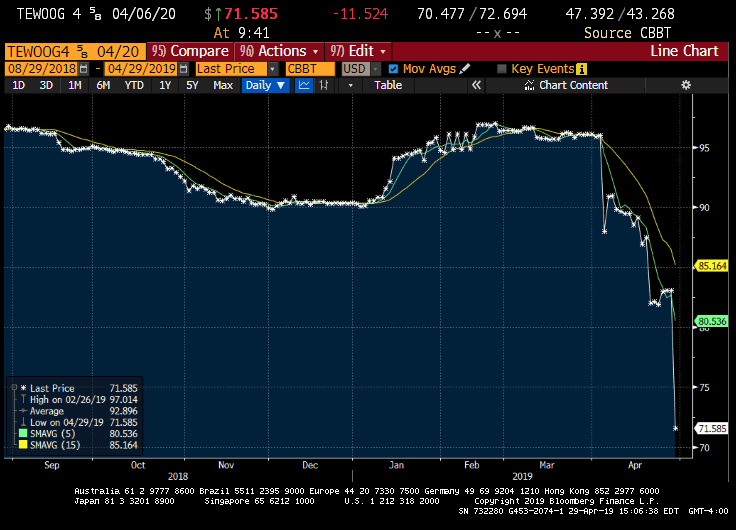Almost daily Grant’s write….The Chinese economy continues to muddle along, as a series of eight indicators compiled by Bloomberg encompassing market sentiment, key commodity prices and overall business conditions showed solid levels of activity in April. That follows a 6.4% reported year-over-year GDP growth rate in the first quarter, above the expected 6.3% but below last year’s 6.6% figure, itself the slowest recorded growth rate since 1990.
But even that middling (by Chinese standards) growth has come through significant exertion, as total new credit footed to 9% of last year’s GDP in the first quarter, a figure which almost matches 2009’s (on an annualized basis) credit injection of 40% of GDP. Bloomberg China economist Qian Wan writes that “policy support is still necessary – that means the government needs to keep spending and driving investment to keep domestic demand stable.”
Loose monetary policy likewise hasn’t been able to forestall increasingly frequent signs of corporate distress. Bloomberg notes today that each of China’s four biggest banks have seen their non-performing loan ratios rise to multi-year highs in the most recent quarter, with bad loans at the Bank of China Ltd. reaching the highest since at least 2006. Data from Bloomberg likewise shows that bonds from 44 Chinese companies totaling $42.9 billion are currently “facing repayment pressure,” up 23% from the end of March. Indeed, a trio of prominent names are in the headlines for all the wrong reasons.
Today, Fitch Ratings cut its appraisal of commodity trader Tewoo Group Co.’s dollar-pay bonds by six notches, to single-B-minus from triple-B-minus following a failed debt-for-equity swap late last year. Tewoo, ranked 132nd on the Fortune Global 500 list, saw its senior unsecured 4 5/8 notes due in April 2020 plunge to 71 cents on the dollar from 95 earlier this month.

Tewoo Group 4 5/8s of 2020. Source: The Bloomberg
Over the weekend, conglomerate CITIC Guoan Group Co., Ltd. failed to make an RMB 3 billion ($450 million) bond payment. Guoan, which reported RMB 178.3 billion in total liabilities as of Sept. 30, saw local courts seize RMB 7.9 billion worth of assets in March. China Lianhe Credit Rating Agency cut its assessment of Guoan to single-A from double-A-minus on April 17. One day later, courts froze the company’s 36.4% stake in Shenzhen-listed CITIC Guoan Information Industry Co., Ltd., which boasts a current market cap of RMB 17.6 billion. Then there’s HNA Group Co., Ltd., the once-massive roll-up now listing under the weight of its gargantuan $80 billion debt load, $25 billion of which matures in less than one year. Since reversing its acquisitive business model last year, HNA sold roughly $45 billion worth of assets in 2018 according to Caijing magazine, but it hasn’t been enough. On April 17, creditors seized golf courses and other pledged assets after the conglomerate was unable to make debt payments. Brock Silvers, managing director at Kaiyuan Capital, told Bloomberg that we can expect more of the same: “While the company seeks further liquidity, it may become increasingly selective in honoring obligations. It’s possible that HNA might not survive 2019’s planned debt obligations in its current form.” Silvers sums it up: “The situation is dire.” China’s efforts to control its bloated credit system carry potentially wide-ranging implications. Chinese banking assets footed to $39 trillion as of Dec. 31, equivalent to 44% of total world GDP in 2018. By comparison, the U.S. and Japan, the world’s largest and third-largest economies (China is second), hold a combined $27 trillion in bank assets.